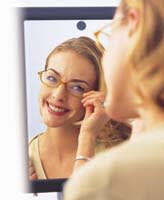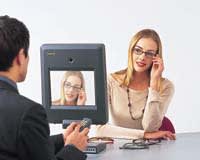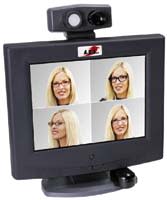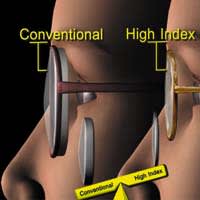
Turn Up the Tech
Savvy practitioners are reporting the use
of technology in the dispensary to be an invaluable sales aid
By Susan P. Tarrant
Technology has changed the way eyecare practitioners work in the exam room. There are autorefractors and corneal topographers. There are retinal cameras and portable keratometers. All of it means patients are treated faster, more thoroughly, and serviced better.
Technology has changed the way eyecare professionals make eyeglasses. Where there once was ground glass and cemented bifocals sealed into metal frames, there is thin and light plastic lenses ground to prescription, complete with modern coatings, and edged to easily fit any frame�all within minutes.
|
|
|
|
Camirror from CBC America is a video imaging mirror that can let the patient compare eyewear or create their own custom lens and tint combinations. |
|
Technology has also changed the way eyecare professionals run their offices. Where there once were stacks of paper files with handwritten notes there is now a computer on every desk, supplies ordered through e-mail, insurance claims processed on-line, and recall software.
So when a patient is witness to this new world of eyecare in the exam room and at the administration desk, why does he or she pick out frames and lenses the same way he has for years? When will technology find a place in the dispensary as well? It has�in a big way with products that are bursting onto the optical landscape.
Video mirrors, information video tapes, animation software explaining eyecare procedures, and virtual try-on systems that allow patients to browse through their favorite optician�s frame collection from home are all making a name for themselves now.
Communication and Marketing
Technology-savvy practitioners are using computers, e-mail, Websites, and computer-generated videos to promote themselves and their product to patients.
"We have 500 patients with e-mail addresses," says William Ramsay, O.D., of Ramsay Eyecare Center in Ft. Myers, Fla., "and we send them newsletters twice a year about new items in the dispensary, sometimes with hyperlinks to certain sections of my Website." Ramsay uses the newsletter to tout not only what�s new in the dispensary and to educate patients about eye health, but also to elicit feedback that he can use in his business. He will often include surveys in his newsletters about patient preferences and habits.
|
|
|
|
The Smart Mirror from American Bright Signs, Inc. lets patients do side-by-side comparisons of their eyewear choices, lens styles, tints, and coatings. The touch-screen or remote control makes it simple. |
The newsletter and e-mails provide Ramsay with constant contact with his patients�something a biennial visit could never replicate. Robert Janot, O.D., who runs a private group practice called 20/20 Vision Clinic with two offices in Lake Charles and Sulphur, La., also likes to communicate with his patient�and he lets his TV monitors do his talking. Janot has monitors placed throughout the clinic and runs a looping video tape containing features and benefits information about lens types, coatings, and general eye health messages. No fancy production costs for him�he simply splices together bits of promotional videotapes he receives from his product vendors. He also includes the appearances he makes on a local news program called "Ask the Expert," in which he�s warning of the dangers of UV, promoting proper eyewear care, or simply talking up the latest lens design or frame fashion.
"The patients, wherever they are in the clinic, are getting the message of what services we offer and what products are available to them," he says.
Ramsay also employs video loops. He creates his on a Power Point program on his computer and it includes information on eye diseases and eye care, products, and general information about the practice. Both approaches are successful.
"I can�t even count how many products [the video loops] have sold," Janot says. "By the time the patient gets to the dispensing discussion, they�re saying, �Oh yeah. I was just watching information about that.�" He says it takes the pressure off the professionals in the office who are uneasy about what they may consider "selling."
Frame and Lens Selection
Anyone who has watched a high-plus patient try to pick out frames knows the frustration: He or she can�t see without their prescription lenses, but must take off their prescription lenses in order to try on new frames with demo lenses. Sure, magnifying mirrors may work, but it�s much more fun and informative to sit the patient down in front of any of the video mirrors on the market now.
The video mirrors�though each unique and offering various functions�generally work this way: An image of the patient�s face is captured and put on a computer screen. The practice�s entire frame stock is downloaded into the computer, so the patient can�with the click of a button or the touch of the screen�"try on" frames. A split screen enables the patient to compare the looks of several frames at once.
"People are just in awe of it," says Norma Diamond, office manager for Neil Diamond, O.D., one of three doctors in a Simi Valley, Calif. practice. The practice had been using one of the image-capturing products for just three weeks at press time, but already she says, "the response has really been fantastic."
The products have more uses than simply frame selection, however. Some are able to replicate the patient�s prescription on a lens image, so the patient can see exactly what the complete eyewear will look like.
The interactive "mirrors" also contain examples of lens styles, tints, and coatings, so the dispenser can show the patient exactly how he or she will look wearing, for example, X frames with Y lens style and a nice AR coating. The side-by-side images allow for comparisons of lens types and coatings versus non-coatings.
"It is a very important sales tool for us in giving the patients a view of exactly what they�ll look like, not only wearing a certain frame style, but lens style and coatings as well," reports Maurice Geldert, O.D., FAAO, of Roswell Vision Source in Roswell, N.M. "At the end of 2000, after a full year of having it in the dispensary, our AR sales were up over 300 percent. We had a substantial increase in our mid- and high-index sales as well."
Some products even take the process one step further, and involve the Internet. The products, such as Eyeweb (from Eyeweb.com) or Activisu (from Interactive Visual System, Inc.), includes a camera that registers the patient�s PD and other measurements along with an image of his or her face. The patient is given a password that allows him to access his image on the optical shop�s Website (available through eyeweb.com) and "browse" through the shop�s inventory of eyewear.
The practitioners are quick to point out that imaging mirrors do not have to take the place of a patient trying on frames...it merely cuts down on the "on/off, on/off, on/off" process. Diamond says the staff at her dispensary have found a way to use the imaging mirrors in yet another way.
"We do a lot of rimless frames, and we like to create custom lens shapes," she explains. "So we�re able to actually draw a lens shape on the person�s image�a lens shape that we can then recreate in our lab." Her staff also uses the product to help patients pick out lens tints if desired. It has done away with the need to stock every possible tint on demo lenses.
|
|
|
|
Animated computer images from Eyemaginations explain lens styles. It also describes procedures and eye diseases. The patient can be guided through the demos, or can watch it by himself. |
|
Animated Software
One of the newer categories popping up in exam room and dispensary technology is animated computer imagery software. Installed on the computer, the doctor can go through a touch-screen activated, moving illustration of a patient�s particular visual problem or impending procedure. Using sound or opting for no sound, practitioners can guide a patient through the procedure or problem directly on the computer screen�making a complex explanation so much easier to intake.
In the dispensary, the software can be used to similarly guide patients (or have them play on their own) through explanations and illustrations of lens styles, features, and benefits, and the like.
"Their retention is a lot better than just handing them a brochure," says Ramsay. "They�re seeing, they�re hearing, and they�re touching."
The response from Ramsay�s patients? Fantastic. And, he says, it�s increased his sales because it has deepened the patients� understanding and appreciation of the premium products.
|
|
|
|
Activisu from IVS (Interactive Video Systems) not only lets the patient compare eyewear, but can hold in its memory the image of every frame in the dispensary. |
"I used to just explain Varilux lenses and give them a brochure. And then the optician would discuss the same thing," he explains. "Now I can say, �I�ve got three lens choices for you, or these coatings for you.� I show them the presentations, and they invariably get the progressives and the coatings. They can actually see what it does for their glasses or how they�ll see with their progressives."
Vin McMahon, O.D. of Eyeworks in Keene, N.H., started using such a program in the exam room, and it�s been so successful with patients that he has ordered another unit for use in the dispensary. He reports the animated information has been invaluable.
"I�ve been squeezing tennis balls and contorting my wrists for years trying to explain astigmatism to patients," he says. "This just makes it so easy. I can�t tell you how many times I�ve heard patients say, �I�ve never really understood that before!�" He adds that the software and its explanations of procedures has also been helpful to ease the fears of people hesitant about the dilation process, because the software�s explanations and diagrams give value to the procedure.
And the overall reaction of his patients? "It�s been stellar," McMahon says. "It puts some excitement back into the visit. And that�s the best kind of advertisement�that people feel they�ve had a very thorough diagnostic and service experience."
The product categories contained here are certainly not the only products that can bring technology into a dispensary, but they�re representative of the kind of technical innovation that is available to professionals.
"Technology has its place in the dispensary," Ramsay says. "It provides a tool. It provides a niche. And you have to have a niche, and a higher level of service. Cutting edge technology, and everything it can bring your patients, is a great niche."
|
Don�t Forget Patient Flow |
|
|
The examination and dispensing conversations are not the only places that technology can play a key role in an optical practice. Barbara Wright, of Barbara Wright Design, a firm specializing in optical dispensaries, recently took on the challenge of incorporating technology to aid patient flow. She worked with Billy J. Cook, O.D. and Vision Health Specialties practice in Midland, Texas to facilitate patient flow and to integrate computers in a patient-friendly atmosphere. "I wanted to create a classic, timeless design that would never go out of style, embrace staff and patients in a warm and welcoming environment, yet accommodate the innovative, computer-driven practice," Wright says. The new process starts as soon as the patient enters the reception area. Through a hidden camera above the counter, their name is immediately shown throughout the building via a network of video screens visible to the staff and doctors. This enables patients to be greeted immediately, and helps doctors, technicians, and staff keep on top of patient wait times and needs. After signing in, patients visit a bank of four computer monitors housed in a custom-designed cabinet in the waiting area. Their personal data sheet is brought up and they enter, via touch-screen technology, new information or updates to their existing charts. All the computers have names, which makes it fun and easy for staff to direct the patients�"Have a seat at Lucy (or Fred, Ethel, or Ricky, in this instance)." These touch-screen interview stations allow patients to input history, hobbies, family members names, etc. The programs are gender- and age-sensitive, requesting the appropriate information for each patient. After the initial work-up, technicians can enter data, refraction, and tonometer readings on touch-screens, which immediately are recorded on the patient�s file. The printouts are then given to the doctor before the exam, allowing him or her to ask about specific problems or hobbies, as well as referring to family members by name. The results of the exam are entered directly into the computer-based charts, and the patient gets a printed prescription at the end of the exam. Billing information and diagnostic codes for insurance purposes are also entered automatically, streamlining the accounting procedure. After being escorted to the dispensary, the optician can access the patient records and prescription, along with all frame and in-house information, on a computer screen located under a glass-top desk�it can only be seen by the optician, preserving privacy. All computers are networked, have credit card authorization programs, and facilitate the flow of patients, their charting updates, and their progress throughout the examination and dispensing processes. All of the computers and technology were designed to be housed in cabinetry and workstations that lend a warm tone to the office design. |
|








